Action
Diving During the Maldivian Monsoons
By: Harvey Edwards
Maldives Promotion House – The seasons in the Maldives are dictated by wind direction. While we call them monsoons, to many people that also has connotations of rain and storms.
The Maldives has two main wind directions or ‘monsoons’. The Iruvai Monsoon comes from the NE, which is the direction of the Indian subcontinent and is generally dry and settled, as it passes over a large land area, and relatively small water. The Iruvai is said to start on December 10th, and runs for approximately 4 months until April 7th.
From mid-April the wind tends to come from the SW, picking up a lot of moisture as it moves over the Indian Ocean. Known as the Hulhangu monsoon, this monsoon actually started in India. As the air starts to warm up over the Indian sub-continent (North-hemisphere summer), the air mass rises sharply and there is a rush of wind to replace it, and as it is coming from the SW (moisture-laden ocean) it brings in the rain. Winds in the Maldives are generally at their strongest in May and the rain begins to fall. The Hulhangu monsoon is known as the wet monsoon because of this. This monsoon runs for approximately 6 months.
We must also take into account the changeover period between the monsoons. The wind can change frequently during this time. Just like an ‘Indian summer’ in other countries, these weather patterns change from year to year, but are fairly consistent in the long run. Four months for the Iruvai, six months for the Hulhangu and two months for the changeover period.
The Maldivian Nakaiy Calendar
| Approximate Date | Nakaiy | Approximate Description |
| Dec. 10 – Dec. 22 | MULA | strong winds, rough seas |
| Dec. 23 – Jan. 05 | FURAHALHA | strong north-easterly winds, rough seas |
| Jan. 06 – Jan. 18 | UTHURAHALHA | clear blue skies, strong winds, rough seas |
| Jan. 19 – Jan. 31 | HUVAN | calm seas, blue skies |
| Feb. 01 – Feb. 13 | DHINASHA | north-easterly winds, moderate seas, plenty of sunshine |
| Feb. 14 – Feb. 26 | HIYAVIHA | seas are calm, days and and nights are hot |
| Feb. 27 – Mar. 11 | FURABADHURUVA | frequent, short, sharp bursts of thunder and lightning |
| Mar. 12 – Mar. 25 | FUSBADHURUVA | usually clear blue skies |
| Mar. 26 – Apr. 07 | REYVA | if storm occur they may be severe |
| Apr. 08 – Apr. 21 | ASSIDHA | begins with storm, then becomes hot and dry |
| Apr. 22 – May 05 | BURUNU | begins with a storm and strong winds, then becomes calm |
| May 06 – May 19 | KETHI | dark clouds, frequent rains |
| May 20 – Jun. 02 | ROANU | storms, strong winds and rough seas |
| Jun. 03 – Jun. 16 | MIYAHELIA | storms, rough seas and strong westerly winds |
| Jun. 17 – Jun. 30 | ADHA | south-westerly winds and light rain |
| Jul. 01 – Jul. 14 | FUNOAS | storms, rough seas, frequent sudden gales |
| Jul. 15 – Jul. 28 | FUS | wet and overcast |
| Jul. 29 – Aug. 10 | AHULIA | less frequent storms, calmer days |
| Aug. 11 – Aug. 23 | MAA | generally calm |
| Aug. 24 – Sep. 06 | FURA | isolated showers, usually dry with light north-westerly winds |
| Sep. 07 – Sep. 20 | UTHURA | strong north-westerly winds |
| Sep. 21 – Oct. 03 | ATHA | generally clear and calm with isolated showers |
| Oct. 04 – Oct. 17 | HITHA | light winds, isolated showers |
| Oct. 18 – Oct. 30 | HEY | strong winds from all directions |
| Nov. 01 – Nov. 13 | VIHA | calm days |
| Nov. 14 – Nov. 26 | NORA | light winds, some sun and showers |
| Nov. 27 – Dec. 09 | DOSHA | light north-easterly winds |
Climate
Take this all with a grain of sand. Large weather patterns affecting the Bay of Bengal for example will have a diluted effect in the Maldives. We are generally considered to be out of the cyclone belt but there have been some nifty storms with cyclones damaging islands forcing evacuations as the islands basically disintegrated due to the persistent pounding of waves in a different direction from normal.
Diving/Staying During the Monsoon
To understand this is to understand the geography of the individual atolls. Have a look at your hotel in regards to East/West.
The Maldives is the lowest country in the world; we’re basically sand banks with a few trees. The outer reef is a barrier reef which does a lot to protect the inner reefs from being smashed to pieces. The coral is usually stunted in the shallows as it gets incredibly strong surge and periodic pounding from waves. Ocean swells of 3 to 5 metres are not uncommon. The surge often gouges out huge grooves in the reef making it look a bit like a tin roof.
If the prevailing wind is coming from the south-west, and your resort is on the south-western side of the atoll you’ll experience the worst of it, or best of it depending on what you want. Villas located over the water can actually shudder when the wind and waves are strong. So it may pay to try to get a room on the eastern side of the island, but then you give up the sunset view. Storms are not common.
For diving this is not necessarily a bad thing. While the weather can be arse, and the winds strong, the wind is also creating the current to a certain extent. While it’s impossible to dive the outside channels when the wind is very strong, the days after can be exhilarating or terrifying to some.
Diving at the western side of the atoll during the SW monsoon you will experience predominantly incoming currents. This means the water is rising from the deep ocean and flowing into the shallow atoll. Viz is generally better, water slightly cooler with better chances to see pelagic. Viz can be 50 metres on a sunny calm day with a good incoming current.
Attention: Can you imagine if it gets worse with 3 to 5 metre swells? Seriously? When good dives go bad here, they can go very very bad, very very quickly. A diver can carry 5 different coloured SMBs, air horns, and mirrors, but if you get pushed outside the atoll in to the ocean when the conditions are like that, you will potentially die simply because the traditional Dhonis (boats) are not stable enough to pick you up. Dhonis are actually very good for the local conditions but most ‘tourist’ Dhonis have a huge wooden sun deck making them very top-heavy. The boat will roll if it attempts to pick you up. Please don’t kid yourself about your abilities to handle yourselves when things go wrong. The ocean is like any dramatic outdoor environment such as a desert, mountain, jungle etc. and conditions change. But these kinds of situations are exceptionally rare and dive centres in Maldives will avoid diving in such situations.
Diving at the eastern side of the atoll at this time you will experience predominantly outgoing current. The viz is generally worse, let’s say 12 to 15 metres. Lots of plankton, lots of fish and better chances to see mantas and whale sharks. The currents this time are going from shallow to deep water. When the currents are strong, it tends to drop at the end of the atoll and so caution must be taken here as well. Viz is poorer, you’re lower on air/deco at the end of the dive, a bad time to start equalising your ears.
Resort/Liveaboard
I have never worked on a liveaboard or safari boat. Resorts are varied in price and service. It all depends on your wants vs. your $$$. The more expensive the resort, the more service you receive in terms of equipment status (assembled/washed), free water, snacks, group size etc.
In a 5* Resort, you will pay approximately USD 100 per dive with rental equipment. Some resorts have Nitrox for free if you are certified. Resorts and diving centres are usually separate entities but they usually match each other in terms of price and service. The DC rents the location from the resort, which rents the location from the island owner. Don’t expect to pay USD 50 per dive if your room costs USD 1000 per night.
The typical schedule is 2 or 3 dives per day. Night dives are usually scheduled once a week but can be arranged depending on whether the DC has their own boats or leases from the island. In this case, the boat crew can be working nights doing supply runs. I suggest tipping boat crew USD 10 each if they change their schedule for you. Three crew per boat is USD 30. Tipping the diving staff is nice but not as important IMO.
5* is not necessarily better for diving. I’ve worked in two 5* and one 4* and dived with another 3*. The best for diving was the 3*, followed by the 4* and surprise, surprise the 5* came last. Many resorts are marketed as spas and retreats and the quality of divers can be a real mixed bag. If you’re on holiday, want to relax and maybe dive an afternoon or 2- that’s great.
If you’re a dedicated diver in a 5* resort it can be tricky as some of the best dives in the Maldives are also the most challenging, not all but some. Some 5* guests complain about having to swim (seriously), but they want the attractions that come with the current. Carrying a reef hook doesn’t mean you don’t have to swim against the current sometimes. So the 5* resort doesn’t go to these spots when the current is strong, sad but true. If you have the money, go private. It’ll cost a bundle but if you can share the costs with other like-minded divers, it’ll be worth it.
For price, you can’t beat the all-inclusive resort. Diving is probably not included, but you’ll save a ton on food and drink costs. The foreign staff will really appreciate any magazines, books etc. Anything really is OK, well maybe not a tatty newspaper, but you get my point. Doesn’t matter which language, most staff speak at least two and know other staff which speaks the language in question. They’ll be stoked and you can save your $$ tips for the Maldivian and especially Bangladeshi crews. Many boat crews are now coming from Bangladesh or Sri Lanka, the captain will be Maldivian. These guys make about USD 150 to 200 per month.
Liveaboards are for the divers who are coming to the Maldives to dive. Price will work out the same as 5* resort based diving, probably cheaper in the long run. You’ll cover more ground and dive more often and if you’re lucky to be diving with like-minded guests, you can pick and choose the sites you’re more interested in. If I was coming on a 10 to 12 day diving vacation holiday, I’d hit the safari boat first and then go to a 4* resort for a few days of R n R afterwards.
Action
The Ritz-Carlton Maldives, Fari Islands announces tennis workshops with Belinda Bencic

The Ritz-Carlton Maldives, Fari Islands is set to host an exclusive tennis exhibition this November, featuring WTA Tour Champion Belinda Bencic. The resort will offer guests an extraordinary weekend of tennis, including exhibition play and immersive workshops under the Maldivian sky.
This unique event is designed as a celebration of sport and community, allowing guests to engage with, learn from, and connect with the tennis star. The weekend will begin with a dynamic exhibition match between Belinda Bencic and the Resort Tennis Pro, which will be followed by complimentary participation for guests.
To provide guests with hands-on experience, the resort has scheduled dedicated workshops for different age groups:
- Adult Tennis Workshop: Saturday, 8 November 2025, from 5:15 PM to 6:30 PM.
- Children’s Tennis Workshop (under 14 years old): Sunday, 9 November 2025, from 5:30 PM to 6:30 PM.
For those seeking a more personalised session, exclusive private classes with Belinda Bencic will be available upon request.
Availability:
- 10 to 15 November 2025.
Pricing:
- A 60-minute session costs USD 360 per guest.
A 60-minute session costs USD 390 per couple.
Guests interested in reservations or more information are encouraged to contact their Aris Meeha.
Action
OZEN LIFE MAADHOO debuts Wind Villa with Jacuzzi & Slide
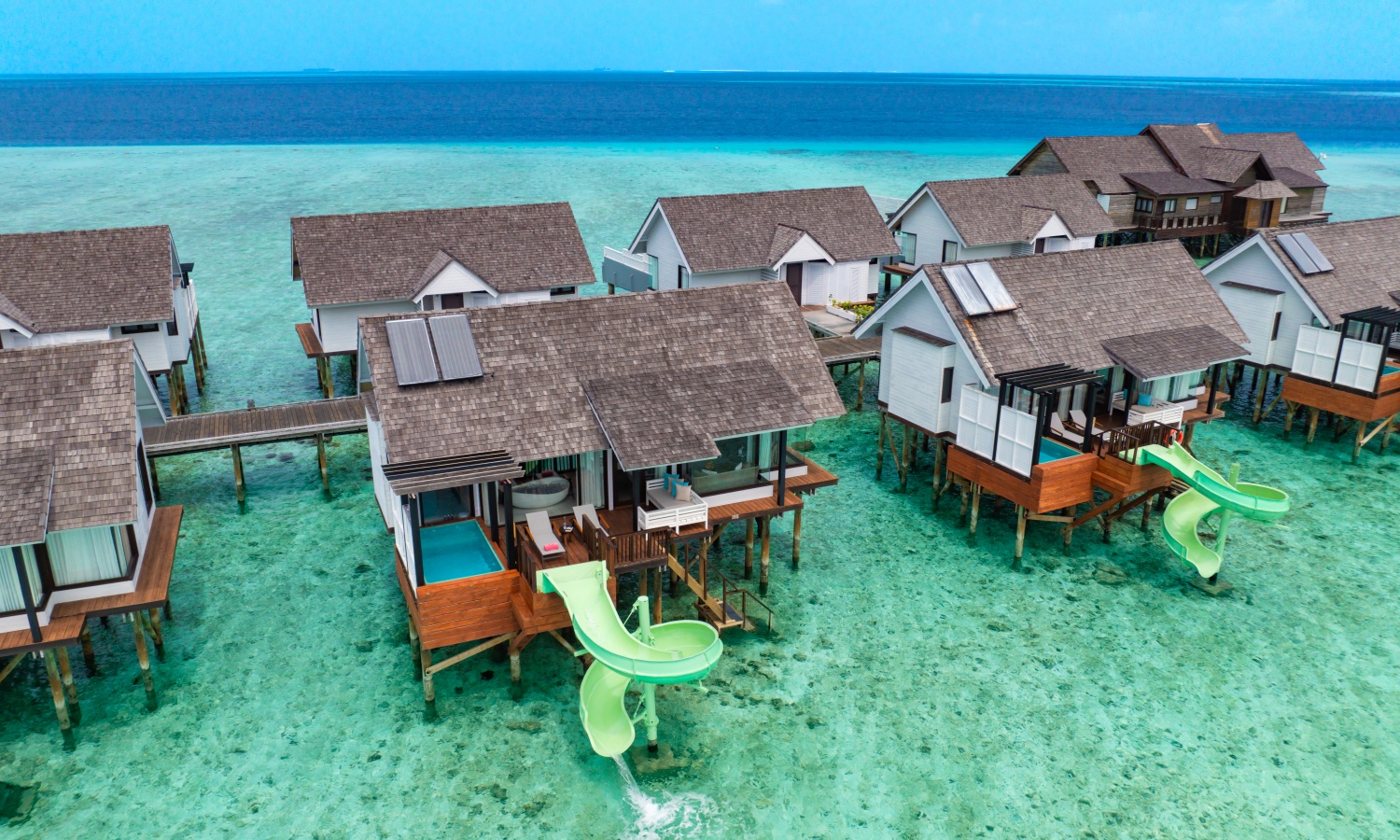
OZEN LIFE MAADHOO has announced the introduction of its newest villa category, the Wind Villa with Jacuzzi & Slide, offering guests a playful yet luxurious twist to their Maldivian getaway. Designed for travellers seeking both relaxation and excitement, the new villa combines captivating ocean views with dynamic features for an unforgettable island experience.
Located at the edge of the island, the Wind Villa enjoys a prime sunrise position and includes a spacious bedroom with high ceilings, an elegant outdoor lounge, and direct access to the lagoon’s clear waters. The addition of a private Jacuzzi and waterslide adds an element of adventure and intimacy, ideal for couples or small families in search of both tranquillity and fun.
Guests can unwind on the sun-drenched deck, enjoy a soothing soak under the Maldivian skies, or take a refreshing slide into the turquoise lagoon, surrounded by the serene beauty of Maadhoo’s shimmering waters.
Stéphane Laguette, Chief Commercial Officer of Atmosphere Core, commented: “Imagining the children’s faces when they see for the first time the striking blue lagoon off the terrace and the bonus of sliding directly into the warm, calm waters below is a joy in itself. What’s even more delightful is the thought of adults embracing the same experience – sliding by day, then later cuddling beneath the starlit Maldivian sky in a hot Jacuzzi, bubbles all around – including in their flute glass! We are thrilled to introduce the Wind Villa with Jacuzzi & Slide, a fresh take on luxury that fuses private leisure with a sense of adventure. This new category reflects our commitment to creating memorable experiences for families and couples seeking a vibrant or romantic island retreat.”
The launch of the Wind Villa coincides with the upcoming holiday season and follows recent enhancements across the resort, including new pool additions to the Earth Villas. OZEN LIFE MAADHOO continues to evolve its offerings to elevate the guest experience.
With its contemporary design, luxurious comforts, and imaginative features, the Wind Villa with Jacuzzi & Slide offers a refreshing balance of indulgence and exhilaration—an experience that perfectly captures the resort’s philosophy of joyful island living.
Stay More & Pay Less with 20% savings when booking directly. These one-of-a-kind exclusive rates ensure a perfectly tailored Maldivian escape. Discover more at theozencollection.com.
Excursions
From first visit to thousand dives: Love story anchored at Bandos Maldives
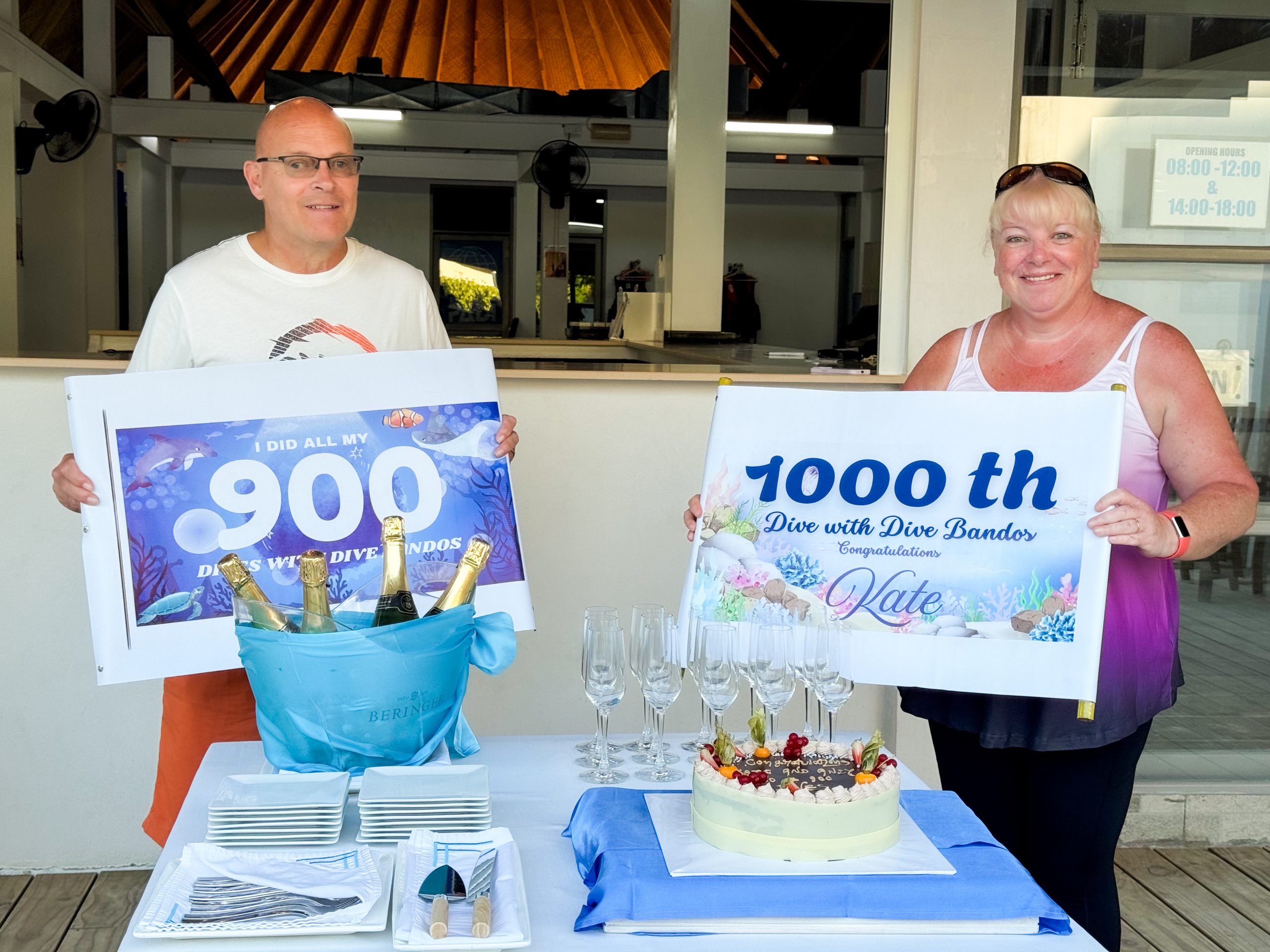
Bandos Maldives recently marked a significant milestone with two of its most loyal guests, Kate and Andy, who have shared a long-standing connection with the island.
Andy achieved an impressive feat by completing his 900th dive, all undertaken with Dive Bandos. His wife, Kate, surpassed this accomplishment by reaching her 1000th dive, with over 900 of those dives also completed alongside the Bandos team.
The Dive Bandos team joined the couple in celebrating this memorable occasion, recognising not only their dedication to diving but also the enduring bond they have formed with the resort over the years.
Kate and Andy’s relationship with Bandos extends far beyond statistics. Having first visited the island in 2006, they have returned every year since, making Bandos an integral part of their lives. In 2014, the couple even chose to exchange their wedding vows underwater at the resort — a unique moment that forever linked their love story with Bandos.
“Celebrating guests like Kate and Andy reminds us of what Bandos truly represents,” said Ismail Rasheed, General Manager of Bandos Maldives.
For Bandos Maldives, moments such as these exemplify why guests continue to choose the island for both adventure and a sense of belonging. With stories like Kate and Andy’s, Bandos stands not merely as a dive destination, but as a home — both beneath and above the waves.
-
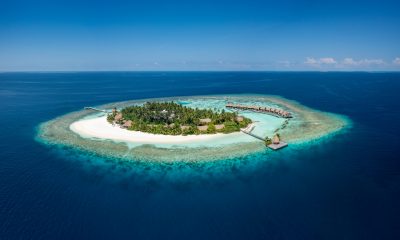
 News1 week ago
News1 week agoUniversal Resorts transforms into VERSA, unveiling NIVA as cornerstone of international growth strategy
-

 Celebration1 week ago
Celebration1 week agoJW Marriott Maldives Resort & Spa unveils ‘Around the World’ festive celebration inspired by global cultures
-
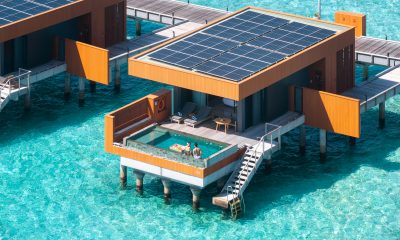
 Featured1 week ago
Featured1 week agoNew era of sustainable luxury: Veligandu Maldives now fully powered by solar energy
-

 Celebration1 week ago
Celebration1 week agoSun Siyam Olhuveli’s dual celebration of Diwali and culinary artistry
-

 Featured6 days ago
Featured6 days agoThe St. Regis Maldives introduces holistic wellness experience with Tash and Andre Barnard
-
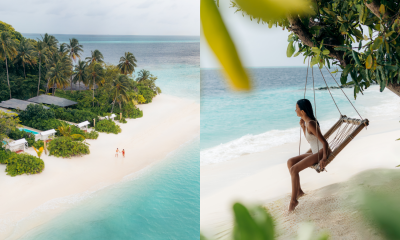
 Featured1 week ago
Featured1 week agoEscape to Baa Atoll with Royal Island’s limited-time winter offer
-

 Celebration6 days ago
Celebration6 days agoCentara Hotels & Resorts lights up Maldives with vibrant Diwali celebrations
-
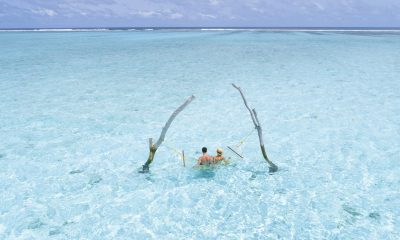
 Awards1 week ago
Awards1 week agoLuxury Lifestyle Awards honours Summer Island Maldives as Best Romantic Resort

















